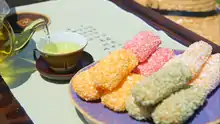 Colorful gangjeong | |
| Type | Yugwa |
|---|---|
| Place of origin | Korea |
| Main ingredients | Glutinous rice flour; cheongju (rice wine); cooking oil; honey; beans, nuts, seeds, pollen, or spice powders |
| Korean name | |
| Hangul | |
|---|---|
| Revised Romanization | gangjeong |
| McCune–Reischauer | kangjŏng |
| IPA | [kaŋ.dʑʌŋ] |
Gangjeong (Korean: 강정) is a hangwa (한과, traditional Korean confection) made with glutinous rice flour. It is a deep-fried "rice puff" with hollow inside, coated with honey followed by nutty beans, nuts, seeds, pollen, or spice powders.[1][2] Gangjeong is often served during important events such as weddings, ancestral rites, and Korean New Year celebrations.[3] Yugwa was widely distributed after the Goryeo Dynasty due to the influence of Buddhism, and was called "Goryeo dessert" in the Yuan Dynasty of China.
Preparation
Glutinous rice is soaked in water for four to five days, then pounded or ground into fine powder.[2] Ten cups of glutinous rice flour is mixed with one-half cup cheongju (rice wine) and one-half cup honey, then steamed in a siru (steamer) lined with a wet bojagi (cloth).[2] The steamed dough is kneaded, rolled into 1 centimetre (0.39 in) thick sheets, cut into rectangles 3–4 centimetres (1.2–1.6 in) long and 1.5–2 centimetres (0.59–0.79 in) wide, and dried in the shade.[2][4] The well-dried gangjeong is first soaked in room-temperature cooking oil, then left to rise a little more in warm oil before it is deep-fried at a high temperature.[2] When all excess oil is drained, the rice puff is coated with honey, followed by nutty grains or powders such as toasted sesame seeds, pine nut powder, soybean powder, pine pollen, Angelica leaf powder, and cinnamon powder.[1][2]
 Pink gangjeong
Pink gangjeong Black sesame gangjeong
Black sesame gangjeong White sesame gangjeong
White sesame gangjeong Gangjeong of many colors
Gangjeong of many colors
See also
Hangaone[5](Hangwa Culture Museum)
References
- 1 2 "gangjeong" 강정. Standard Korean Language Dictionary (in Korean). National Institute of Korean Language. Retrieved 24 April 2017.
- 1 2 3 4 5 6 "gangjeong" 강정 [Deep-fried Sweet Rice Puffs]. Doopedia (in Korean). Doosan Corporation. Retrieved 24 April 2017.
- ↑ National Institute of Korean Language (2002). An Illustrated Guide to Korean Culture: 233 Traditional Key Words. Seoul: Hakgojae. pp. 112–113. ISBN 9788985846981.
- ↑ "Hangwa". Korean Food Foundation. Retrieved 24 April 2017.
- ↑ "한과문화박물관 한가원". hangaone.com (in Korean). Retrieved 2021-04-25.